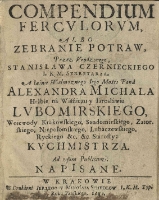Rosół is the first recipe in the oldest polish cookbook. It is also still one of the most popular polish soups. Served on family dinners and a traditional soup for weddings. It is also said to be a great remedy if you catch a cold.
The name "rosół" derives from a dish made of salted meat (old conservation method) cooked in water to make it more edible. Later fresh meat was used instead of salted. Much later that dish of cooked meat became a soup that we know today.
So, on to the recipe from year 1682:
This is the way to cook polish rosół: take beef meat or veal,
hazel grouse or partridge, pigeon and whatever meat that in rosół can be cooked.
Soak it, lay in pot, then strain and pour over meat,
add parsley, butter, salt, and skim well.
One have to know what to put in rosół to not stink of water or wind,
that is parsley, dill, onion or garlic, nutmeg or rosmarin or pepper to taste.
Lime will not spoil any rosół as well.
Here a small side note: the translations from old polish are entirely mine, this is not professional translation, some words or even sentences are omitted, order of words can be changed and so on. All credits for any mistakes should go to me!
I think it would be a very interesting experiment to try this recipe out.
Here are the ingredients that I managed to get:
beef with bone 0,5 kg
veal with bone 0,4 kg
guinea fowl (instead of pigeon or partridge) 1,3 kg
3 parsley roots and green parsley
butter (I dared to use 1 spoon only)
1 large onion
2 cloves of garlic
1 bunch of green dill
rosmarin
black pepper corns
lime
Wash meat under running warm water, lay it in pot. Pour cold water so that it covers meat. Add salt (about 1 teaspoon) and pepper corns and bring it to boil (not too fast), then turn the fire down to a very small one and let it simmer under cover very slowly from now on. Add parsley roots, whole cloves garlic (peeled), halved onion (I left it unpeeled), butter, rosmarin.The cooking should take at least 3 hours so be patient! At the end of cooking check taste and add some salt if necessary.
What next?
When rosół is ready you can either serve it right away (old style) with all the meat inside, just add some chopped green parsley, dill and few dashes of lime juice, or
take out meat, sieve the soup and serve it with above mentioned herbs and lime with for example slices of bread toasted over open fire :)
The experiment went really well. This old recipe is worth trying out! It wasnt fat at all and after cooling it became jellyous, which means rosół was of a very fine quality.
Here is a modern recipe for rosół for comparison:
50-70 dag beef with bone, not too fat
1/4-1/2 of hen
1-2 carrots
1 parsley root
1/2 of celeriac root
1/2 of leek
1 onion
2-4 bay leaves
4-6 pepper corns
4 allspice
Some recipes also claim for a piece of cabbage, whole garlic clove, several dried mushrooms, lovage or maggi,
Put meat in pot, pour cold (it has to be cold!) water over it (about 2-3 liters), salt and bring it rather slowly to boil. Turn fire down immediately and let it simmer from now on on a very very little fire. Put washed, peeled vegetables (whole or in large chunks) inside and spices, onion should be halved and browned over open fire. Let it cook for 3 hours or so. Dont let it boil it can only simmer! Taste and add salt if necessary. Now when rosół is ready:
--> you can clarify it by sieving through a very fine sieve
--> remove excess fat by cooling it and taking it off from a surface with a spoon.
--> Serve it with home made pasta, sliced carrots that were used in cooking, and green parsley. Some fresh black pepper might also do!
Wednesday, March 24, 2010
Wednesday, March 3, 2010
The oldest polish cookbook
The oldest polish cookbook was published in 1682. It was written by Stanisław Czerniecki, master chef in the noble house of Lubomirski family. "Compendium ferculorum albo zebranie potraw" gives us insight in the traditional old polish cuisine. The author claims that polish cookery characterizes:
- use of spices (saffron, ginger, cloves, coriader, pepper) in large quanities that gave hot, spicy taste to dishes
- combining sour (vinegar) and sweet (sugar) flavors in one dish
- use of beer and beer vinegar in contradiction to wine that Czerniecki rejected
- Czerniecki also mentioned that one should use raisins only in dishes that are sweet
- and that one shouldnt use bread crumbs for every dish because it makes every dish taste the same
- we can see that bread, soups and pork were not popular among noblemen back then
- they ate lots of wild game, wild birds, beef, mutton, capons and since large quanity of fasts lots of fish dishes,
Subscribe to:
Posts (Atom)

